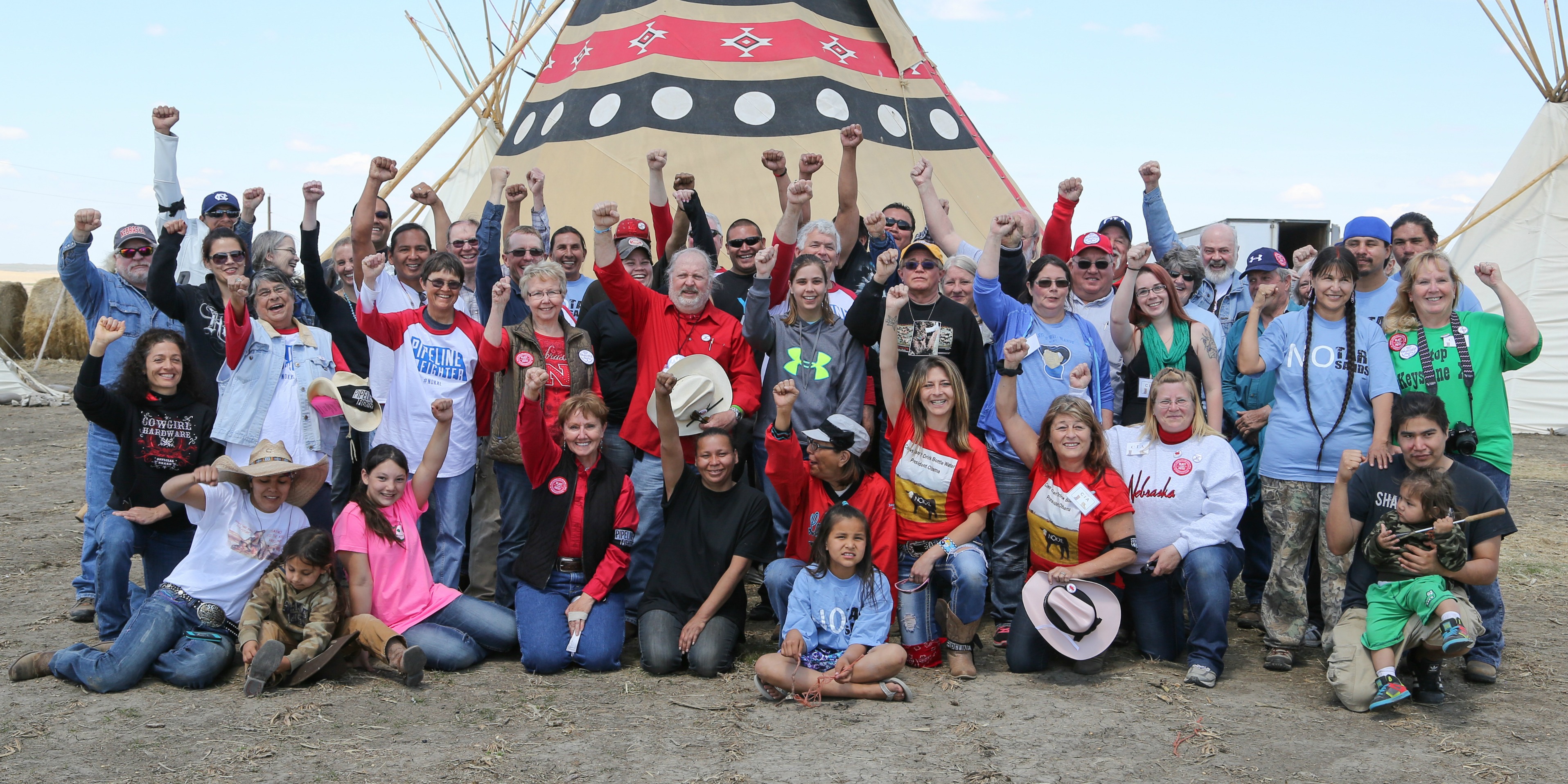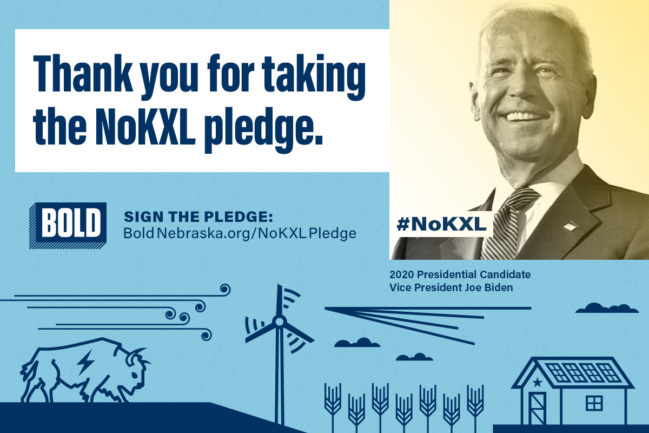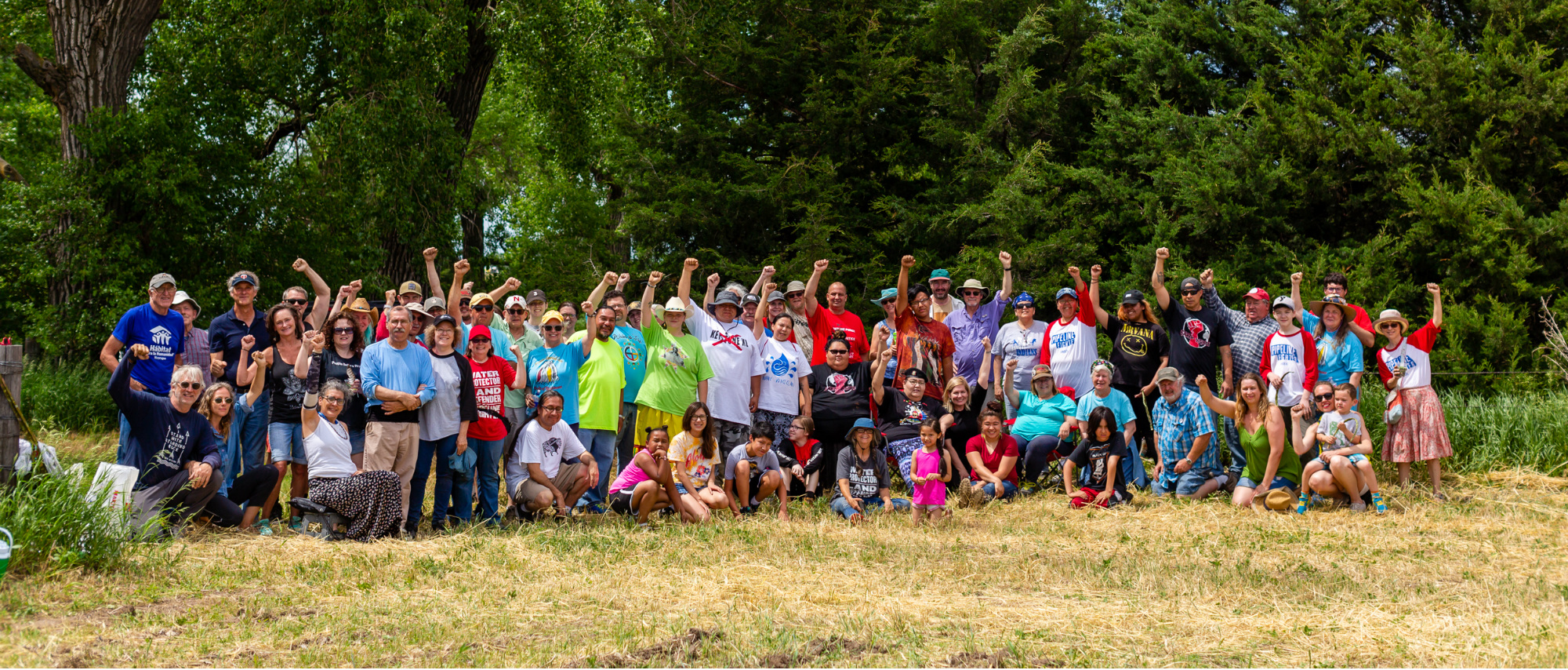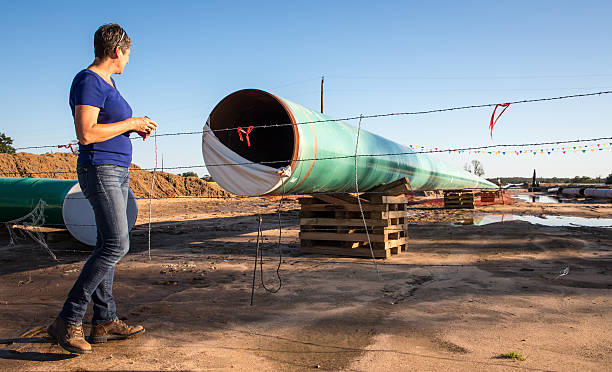
Rosebud Sioux Tribe Sprit Camp to Stop Keystone XL (Photo: Matt Sloan for Bold Nebraska)
 Following a year-long grassroots campaign launched in August 2020, which successfully pressured nearly all of the Democratic presidential candidates to sign onto a “NoKXL Pledge” to stop the pipeline if elected, then-nominee Joe Biden announced on May 18, 2020 that he would rescind the KXL permit if he were to be elected.
Following a year-long grassroots campaign launched in August 2020, which successfully pressured nearly all of the Democratic presidential candidates to sign onto a “NoKXL Pledge” to stop the pipeline if elected, then-nominee Joe Biden announced on May 18, 2020 that he would rescind the KXL permit if he were to be elected.
On his first day in office on Jan. 20, 2021, President Biden kept his campaign promise and rescinded Keystone XL’s Presidential Permit, effectively killing the project.
Despite now lacking this fundamental permit, TransCanada / TC Energy has so far refused to relinquish easements to landowners that it acquired for the pipeline either voluntarily or through the courts via eminent domain condemnation — and has even initiated new eminent domain condemnation lawsuits against Nebraska landowners in April 2021 — months after President Biden revoked the company’s permit.
Republican supporters of the project in Congress and some U.S. states have also launched last-ditch efforts to try to resurrect the project, including a failed amendments to major legislation that could have re-authorized the revoked permit; a lawsuit filed by 21 state attorneys general seeking to overturn President Biden’s revocation of the permit; and a “forum” held by minority Republicans on the U.S. House Energy & Commerce Committee (“President Biden’s Cancellation of the Keystone XL Pipeline and American Jobs”).
Landowners in Nebraska are reviewing legal and legislative options, and efforts are underway to compel TransCanada to relinquish the Keystone XL easements, and restore and return the land.

2019 Sacred Ponca Corn Planting in the Path of Keystone XL (Photo: Alex Matzke for Bold Nebraska)
Recent Media Coverage
- (May 7, 2021): E&E News: TC Energy could be walking away from Keystone XL
- (April 12, 2021): NET Nebraska: KXL Pipeline Developer Presses Land Acquisition Despite Federal Block On Project
- (March 17, 2021): Associated Press: States sue Biden in bid to revive Keystone XL pipeline
- (Jan. 20, 2021): The New Yorker: Joe Biden’s Cancellation of the Keystone XL Pipeline is a Landmark in the Climate Fight
- (Jan. 24, 2017): Associated Press: A timeline of the Keystone XL oil pipeline
Project Details
- Owner: TransCanada / TC Energy
- Capacity: 700,000 barrels per day
- Length: 2,151 miles, Hardisty, Alberta to Pakota, Ill., and Port Arthur, Texas (MAP)
- Diameter: 36-inches
- Cost: $8 billion; $1.5 billion spent on “construction”
- Status: CANCELLED
- Start Year: N/A
- Bank lenders:
- April 2, 2020: Citi and JPMorgan Chase lead a $1.25 billion bond issuance for TC Energy, co-managed by Mizuho, MUFG, SMBC and others [source]
- April 1, 2020: Bank of Montreal, Royal Bank of Canada, Scotiabank and TD leda a CAD $2 billion bond issuance, with BlackRock as a bond holder.
- March 2020: Government of Alberta ($1.1 billion investment; $4.2 billion loan guarantee)
- December 2019: $5 billion revolving credit facility renewal led by JP Morgan Chase and Bank of Montreal with 18 other institutions participating
- Insurers: Liberty Mutual [source]
Project Status
Eminent Domain:
- Nebraska Easement Action Team: Nebraska Easement Action Team, Inc. (“N.E.A.T.”) is a non-profit education and legal defense fund established by Nebraskans for the benefit of landowners and citizens affected by the TransCanada Keystone XL pipeline. N.E.A.T.’s legal counsel, Omaha-based Domina Law Group, has decades of experience with easements and eminent domain issues, condemnation, and has been involved with all issues related to TransCanada and landowners from day one of the KXL project. The firm also handles the hiring of other experts like engineers, ecologists, hydrologists, and pipeline safety experts who can help quantify known risks such as pipeline ruptures, and others if deemed necessary to advise N.E.A.T. on developing and negotiating the strongest possible easement terms to protect landowners.
- April 2021: Nebraska landowners and others on the proposed KXL route — including those in Nebraska who never signed an easement and are still in the midst of eminent domain condemnation proceedings — are now petitioning state agencies and TC Energy to release the pipeline easements, and return their land.
- December 2020: Nebraska courts find recent changes to Keystone XL Pipeline route may require new state approval [source]
Indigenous Free, Prior & Informed Consent; Consultation & Environmental Justice:
- No free, prior & informed consent. Free, Prior and Informed Consent (FPIC) is a specific right that pertains to Indigenous peoples and is recognized in the United Nations Declaration on the Rights of Indigenous Peoples (UNDRIP). It allows them to give or withhold consent to a project that may affect them or their territories. Once they have given their consent, they can withdraw it at any stage. Furthermore, FPIC enables them to negotiate the conditions under which the project will be designed, implemented, monitored and evaluated. This is also embedded within the universal right to self-determination. [source]
- September 2020: Chairman Larry Wright, Jr. of the Ponca Tribe of Nebraska tells the U.S. State Dept. that “the Tribe cannot participate in so-called surveys that are clearly inadequate and will in no manner meet the obligations of DOS or TC Energy with respect to cultural and historic resources.” [source]
- December 2020: Pipeline re-routed to avoid impacts to Ponca Nation land deeded by a farmer near Neligh, Nebraska and to USDA-registered Ponca Sacred Corn grown on the land. [source]
Outstanding Permits:
- January 2021: Presidential permit revoked by President Joe Biden on Jan. 20, 2021.
- Nationwide Permit 12 (NWP 12) bulk water-crossing permit challenged in court by environmental and Indigenous organizations for violations of National Environmental Policy Act
- November 2017: Nebraska Public Service Commission in 3-2 vote approves Keystone XL route in Nebraska, but instead of TransCanada’s “Preferred” route, the PSC approves a “Mainline Alternative Route” that includes new affected landowners. [source]
Impact Litigation / Court Fights
- Federal Court:
- March 2021: 21 states with GOP Attorneys General sue Biden administration for revoking the Keystone XL presidential permit [source]
- November 2018: U.S. District Judge Brian M. Morris blocked the permit issued by the Trump administration, ruling that a supplemental environmental review had to be completed before the construction could proceed.
- Court rules…Nationwide Permit 12 (NWP 12) bulk water-crossing permit challenged in court by environmental and Indigenous organizations for violations of National Environmental Policy Act
- U.S. Supreme Court declines to hear appeal, keeping the lower court’s injunction in place and NWP 12 permit vacated
- State Court:
- March-April 2021: Despite lacking a presidential permit, TransCanada / TC Energy initiates new eminent domain condemnation proceedings against Nebraska landowners in county courts. [source]
- December 2020: Nebraska courts find recent changes to Keystone XL Pipeline route may require new state approval [source]
- TransCanada begins to file eminent domain condemnation lawsuits against 90+ Nebraska farmer and rancher landowners who refused to sign easements on their land for Keystone XL [source]
- August 2019: Nebraska Supreme Court upholds law that ignores landowners’ property rights, Indigenous sovereignty in flawed decision on Keystone XL Pipeline route [source]
- December 2017: Landowners file appeal of Keystone XL route approval by Nebraska Public Service Commission [source]
HISTORY
TransCanada’s first “Keystone” pipeline was constructed in 2010 and runs 2,151 from the Western Canadian Sedimentary Basin in Alberta, Canada to refineries in Illinois and Texas, and also to oil tank farms and an oil pipeline distribution center in Cushing, Oklahoma.

Texas landowner Julia Trigg Crawford and others fought eminent domain for the “Southern leg” of the proposed Keystone XL pipeline that was authorized by the Obama administration, but the Texas Supreme Court authorized eminent domain and the southern leg was completed in 2015.
The “Gulf Coast Extension” or “Marketlink” pipeline expansion of the Keystone system, as it is now called, was originally an intended portion of the Keystone XL expansion of the Keystone system. When then-President Obama rejected the cross-border permit for the longer Keystone XL segment from Alberta to Nebraska in 2010, TransCanada was granted a consolation prize in 2014 in the form of an authorization to construct and operate a shortened, 487-mile interstate KXL segment that did not cross the Canadian border on its route from Cushing, OK to the refineries in Port Arthur, Texas.
The Obama administration rejected the project in 2015 as not in the U.S. national interest. Following the pipeline’s rejection in 2015, in 2016 TransCanada filed a lawsuit as well as a $15 billion case against the U.S. for losses under the North American Free Trade Agreements’s (NAFTA) “Investor State Dispute Settlement” arbitration process.
The arbitration case was suspended in March 2017, shortly after incoming President Donald Trump early in office approved a permit for the pipeline in 2017, via executive order.
Despite the Trump administration’s efforts to aid approval and speed development of the project, landowners’ resistance in Nebraska, and ongoing legal battles led by Indigenous and environmental groups produced significant obstacles for TC Energy. These included a revocation of the company’s “Nationwide Permit 12” blanket water-crossing permit that came with an injunction blocking construction, and a challenge to the legality of the approval process used by the Nebraska Public Service Commission to authorize the pipeline’s route that included that precluded the company from constructing in Nebraska from December 2017 – August 2019.
The Trump administration shortly thereafter issued a new cross-border authorization presidential permit, also via executive order.
KEYSTONE PIPELINE: 21 SPILLS: (2010-19)
- TransCanada stated to the public, state and federal agencies, and elected officials before its first Keystone pipeline started construction in 2010 in a risk assessment prepared by ENSR / AECOM that it estimated the pipeline would spill eleven (11) times over the course of its expected lifetime (approx. 50-100 years).
- Dr. John Stansbury of the University of Nebraska at Lincoln also conducted an independent analysis that provides more detail on the potential risks for the Ogallala Aquifer than the analysis offered by TransCanada. In his analysis of potential risks of spills on the Keystone pipeline, Dr. Stansbury of UNL concluded that safety assessments provided by TransCanada are misleading. According to Dr. Stansbury, “We can expect no fewer than 2 major spills per state during the 50-year projected lifetime of the pipeline. These spills could release as much as 180 thousand barrels of oil each.”
- The Keystone pipeline has in fact experienced at least 21 documented spills so far during its 11-years in operation — including spills of at least 380,000 gallons in North Dakota in October 2019, and 407,000 gallons near Amherst, South Dakota in November 2017. [source]
- View Bold Nebraska’s report with details and reported causes for all of the documented spills on TransCanada’s Keystone pipeline: HISTORY OF SPILLS: TransCanada’s Keystone pipeline (21 SPILLS: 2010-19)
This interactive map compiled by Greenpeace USA / Tim Donaghy shows the locations and relative size of all 21 spills on TransCanada’s Keystone pipeline:
[Select information and map data excerpted from Global Energy Monitor, with permission and Creative Commons license.]


